

The Aleutians

The Lands of 50 mph Fog
© HLSWILLIWAW.COM
Built with XARA
Consolidated PB4Y-2 “Privateer”
The Consolidated PB4Y-2 Privateer was a United States Navy long range patrol bomber derived from the Consolidated B-24
Liberator. At the outbreak of World War II the Navy lacked any long-range land based patrol bombers to conduct search, anti-
submarine, and anti-shipping missions. In 1942 the navy put in a request for 977 B-24s designated PB4Y-1. While PB4Y-1s
distinguished themselves in the Atlantic and the Pacific, it was still essentially a B-24 designed for high altitude flight, not low
altitude patrol missions
In 1943 the Navy asked Consolidated for a new patrol bomber based on the B-24. The PB4Y-2 design incorporated many
changes including a single vertical tail, more armament, low level engines, and a stretched fuselage. The Privateer also had
state of the art search radars and navigation equipment giving the aircraft an all-weather capability. By 1945 several squadrons
of Privateers were conducting operations from the Philippines to the Aleutian Islands. The PB4Y-2 stayed in Navy service after
the war where it took on additional missions such as weather reconnaissance, and the gathering of signal intelligence before
being retired around 1955. After their retirement, several Privateers were modified and used as civilian air tankers used in
fighting forest fires until 2002. [ https://pimaair.org/museum-aircraft/consolidated-pb4y-2/ ]
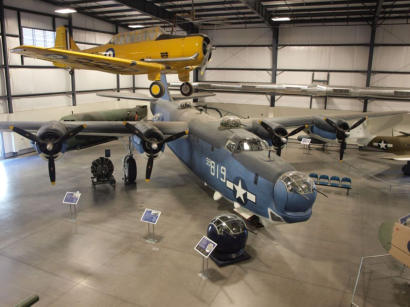
Pima Air & Space Museum: Consolidated PB4Y-2 “Privateer”.
SPECIFICATIONS:
Wingspan: 110 ft
Length: 74 ft 7 in.
Height: 29 ft 2 in.
Weight: 62,000 lbs (loaded)
Maximum Speed: 300 MPH
Service Ceiling: 21,000 ft
Range: 3,000 miles
Engines: Four Pratt & Whitney R-1830-94 radials with 1,350 horsepower each
Crew: 11
Manufacturer: Consolidated
Markings: Patrol Bombing Squadron 120 (VPB-120), Shemya Island, 1945
Designation: PB4Y-2
Registration: N3739G
Serial Number: 59819
The following photos were provided by George Villasenor, an Aleutian WWII Navy Combat Photographer working out of Attu,
circa 1945. Aircraft reference information from “Jane”s Historic Military Aircraft.
Consolidated PB4Y-2 "Privateer" WWII
The U.S. Navy made heavy use of their USAAF Service configured B-24D-derived PB4Y-1 Liberators from August 1942 onwards
in the Pacific and over the Atlantic. In early 1943, the Navy placed a contract for an aircraft based on the original B-24D
Liberator design with enhancements for their use as a dedicated naval long-range patrol bomber. Three B-24Ds were taken off
the San Diego production line and modified with a lengthened fuselage (by 7 feet), navalized interiors, greater defensive
armament, modified engine cowlings, and a distinctive vertical tail similar to that fitted to the final Liberator transport variant.
The Navy ordered 739 aircraft in a single production run, with 286 delivered in 1944 and the remainder in 1945. Few had reached
the front lines by VJ-Day, although VP-24 did achieve operational status with the Bat anti-cruise missile in the weeks prior to
Japan's surrender. The Privateer went on to perform its best work during the Cold War era as a radar and electronic
countermeasures platform. It was re-designated as the P4Y in 1951. After service with the U.S. Coast Guard, the final units were
retired in the early 1960s.
First Flight Date: 20 September 1943
Powerplants: Four Pratt & Whitney 1350-hp R-1830-94 Twin Wasp engines
Max Speed: 237 mph
Range: 2,800 miles
Weight: Empty 37,485 lbs; Max (Take-off) 65,000 lbs
Dimensions
Wingspan: 110 ft 0 inches
Height: 30 ft 1 inch
Length: 74 ft 7 in
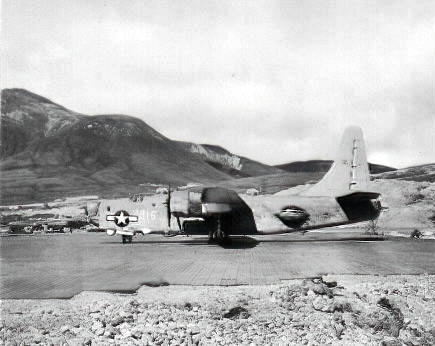

This photo of a Navy PB4Y Privateer on
Attu was taken by George Villasenor.
This aircraft was originally derived from
the Army Air Force's B-24D. Attu, AK.
Circa 1945.
Another view of the Navy PB4Y Privateer
by George Villasenor. Attu, AK. Circa
1945.
Current Update: 09 Dec 2021
Last Updated: 04 Jan 2013 11:53


The Aleutians

The Lands of 50 mph Fog
Consolidated PB4Y-2 “Privateer”
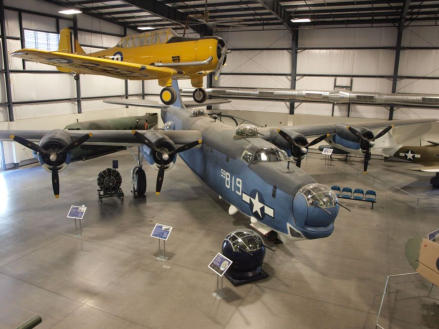
Pima Air & Space Museum: Consolidated PB4Y-2
“Privateer”.
SPECIFICATIONS:
Wingspan: 110 ft
Length: 74 ft 7 in.
Height: 29 ft 2 in.
Weight: 62,000 lbs (loaded)
Maximum Speed: 300 MPH
Service Ceiling: 21,000 ft
Range: 3,000 miles
Engines: Four Pratt & Whitney R-1830-94 radials with 1,350
horsepower each
Crew: 11
Manufacturer: Consolidated
Markings: Patrol Bombing Squadron 120 (VPB-120), Shemya
Island, 1945
Designation: PB4Y-2
Registration: N3739G
Serial Number: 59819
The Consolidated PB4Y-2 Privateer was a United States Navy
long range patrol bomber derived from the Consolidated B-24
Liberator. At the outbreak of World War II the Navy lacked any
long-range land based patrol bombers to conduct search, anti-
submarine, and anti-shipping missions. In 1942 the navy put in a
request for 977 B-24s designated PB4Y-1. While PB4Y-1s
distinguished themselves in the Atlantic and the Pacific, it was
still essentially a B-24 designed for high altitude flight, not low
altitude patrol missions
In 1943 the Navy asked Consolidated for a new patrol bomber
based on the B-24. The PB4Y-2 design incorporated many
changes including a single vertical tail, more armament, low level
engines, and a stretched fuselage. The Privateer also had state of
the art search radars and navigation equipment giving the aircraft
an all-weather capability. By 1945 several squadrons of Privateers
were conducting operations from the Philippines to the Aleutian
Islands. The PB4Y-2 stayed in Navy service after the war where it
took on additional missions such as weather reconnaissance,
and the gathering of signal intelligence before being retired
around 1955. After their retirement, several Privateers were
modified and used as civilian air tankers used in fighting forest
fires until 2002. [ https://pimaair.org/museum-
aircraft/consolidated-pb4y-2/ ]
The following photos were provided by George Villasenor, an
Aleutian WWII Navy Combat Photographer working out of Attu,
circa 1945. Aircraft reference information from “Jane”s Historic
Military Aircraft.
Consolidated PB4Y-2 "Privateer" WWII
The U.S. Navy made heavy use of their USAAF Service
configured B-24D-derived PB4Y-1 Liberators from August 1942
onwards in the Pacific and over the Atlantic. In early 1943, the
Navy placed a contract for an aircraft based on the original B-24D
Liberator design with enhancements for their use as a dedicated
naval long-range patrol bomber. Three B-24Ds were taken off the
San Diego production line and modified with a lengthened
fuselage (by 7 feet), navalized interiors, greater defensive
armament, modified engine cowlings, and a distinctive vertical
tail similar to that fitted to the final Liberator transport variant.
The Navy ordered 739 aircraft in a single production run, with 286
delivered in 1944 and the remainder in 1945. Few had reached the
front lines by VJ-Day, although VP-24 did achieve operational
status with the Bat anti-cruise missile in the weeks prior to
Japan's surrender. The Privateer went on to perform its best work
during the Cold War era as a radar and electronic
countermeasures platform. It was re-designated as the P4Y in
1951. After service with the U.S. Coast Guard, the final units were
retired in the early 1960s.
First Flight Date: 20 September 1943
Powerplants: Four Pratt & Whitney 1350-hp R-1830-94 Twin Wasp
engines
Max Speed: 237 mph
Range: 2,800 miles
Weight: Empty 37,485 lbs; Max (Take-off) 65,000 lbs
Dimensions
Wingspan: 110 ft 0 inches
Height: 30 ft 1 inch
Length: 74 ft 7 in
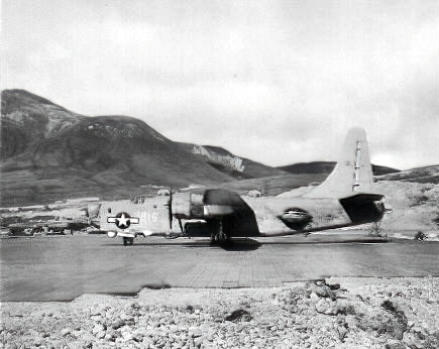
This photo of a Navy PB4Y Privateer on Attu was
taken by George Villasenor. This aircraft was
originally derived from the Army Air Force's B-24D.
Attu, AK. Circa 1945.
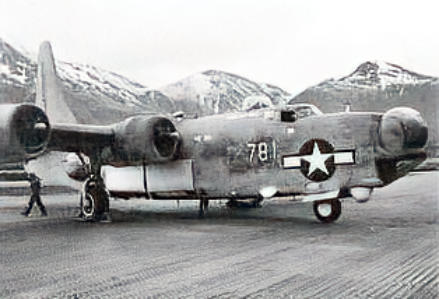
Another view of the Navy PB4Y Privateer by
George Villasenor. Attu, AK. Circa 1945.
Current Update: 09 Dec 2021
Last Updated: 04 Jan 2013 11:53
© HLSWILLIWAW.COM
Built with XARA





























